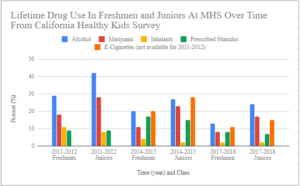
The graph displays data from the California Healthy Kids survey concerning an individual student’s drug use. The survey is taken biannually, targeting 9th and 11th graders, and indicates decreasing drug use.
By: Neval Mulaomerovic and Luke Ren
Drug use is on the rise in MHS with the increased availability of marijuana and vape pens, Assistant Principal Jennifer Hutchison said. The legalization of marijuana and the increase in acceptance towards drug use has contributed to this growing trend, she said.
Rising drug use among high school students can be attributed to flaws in the system, Hutchison said. Places that sell products such as vape pens might not ask for identification from underage kids who look older than they are, and students may also gain access to their parents’ prescription drugs at home, she said.
“We definitely have a rise in vape usage,” Hutchison said. “Studies are showing that it’s on the rise. Since marijuana has been legalized, it much [drugs] more accessible and the society’s view on whether it’s good or bad for you has also changed because of that. We’ve also seen students on Xanax. Xanax when not prescribed for an individual causes a lot of changes neurologically and can be extremely dangerous causing medical conditions.”
Students are exposed to drug use more than ever before, Junior Mahika More said. Society has become more open and accepting towards teenage drug use, allowing more students to enter the lifestyle without proper knowledge on the negative aspects, she said.
“People talk about [drugs] a lot more openly than they did before,” More said. “Kids might also try it because their friends try it and they want to fit in. It’s important to know that there are real consequences to using drugs, and it’s not something that you should become dependent on at such a young age.”
Drug use can seriously impact a student’s performance in school, Hutchison said. Students tend to feel more tired and less motivated in physical and mental activities in school, she said.
“The reality is the health conditions that come as a result of [drug use] are very real,” Hutchison said. “Instead of trying to scare people from it, we need to educate them so they’re making responsible decisions based on factual scientific evidence. We need to continue to do a good job at reaching out to individuals who have emotional issues or concerns so that they have coping strategies that are healthy rather than harmful.”
About 8 percent and 17 percent of MHS Freshmen and Juniors respectively have used marijuana at least once in their lifetime, according to the 2017-2018 California Healthy Kids Survey. Nearly 11 percent and 15 percent of MHS Freshmen and Juniors respectively have used an e-cigarette before, according to the same survey.
The same survey held four years prior indicated that there had actually been a decrease in marijuana and e-cigarette activity since, according to the 2014-2015 California Healthy Kids Survey. Marijuana use was measured to be 11 percent and 23 percent in MHS Freshmen and Juniors respectively; e-cigarette use was measured to be 20 percent and 28 percent in MHS Freshmen and Juniors respectively, according to the same survey.
Drug activity has remained constant, not visibly increasing from previous years, Senior Connor Lingle said. The school would also have trouble creating an effective method of preventing drug use, Lingle added.
“I think if students talk to each other about safe drug use or practices, it would be more effective than a school administrator,” Lingle said. “However, since it’s ‘cool’ to do drugs, and like vaping is really popular now, I find it hard to see students telling other students to stop drug activity, in fear of being ostracized by their friend group.”
Preventing drug use can start at the student level, School Psychologist Noheli Guerrero said. Since drugs are often used as a coping mechanism, reaching out to students who are struggling with larger issues can help them find stability instead of falling into unhealthy patterns, she said.
“I would recommend having more clubs available for students to have that type of leadership opportunity and hopefully attract those students who feel lonely or maybe want to fit in with other crowds and that’s why they’re doing drugs,” Guerrero said. “When you think about it, drugs can either be something that they’re doing to fit in or it could be a coping mechanism for support that they’re not getting in other areas. Everyone does it for a different reason, but I think if we can pinpoint what those reasons are, then we can be there for them.”
Counseling And Support Services for Youth therapists, counselors, and social workers are available for students seeking help on campus, Hutchison said. These resources serve as a safe space for students to discuss the underlying issues of what is leading them to try drugs or alcohol and work through their emotions, she said.
“All of us admin are very comfortable and skilled in working with adolescents in identifying drug and alcohol issues,” Hutchison said. “We’re the first line. We will also often times work with families to look at what resources we have or if we can help them work with their insurance to figure out if there are services outside of the school or even working with their own pediatricians and doctors for support or counseling to deal with it.”
In the case of a student overdosing on campus, first responders are notified immediately, Guerrero said. Health and safety are the first priorities when dealing with student drug use, she said.
“We don’t waste time,” Guerrero said. “We call 9-1-1. We don’t second guess because we don’t know what the situation is. We can’t let students know the cause of death. We can only be here to support them. This is a person who has a family, who left behind a family, and we’re doing a disservice if we allow those rumors to persist because they can be really hurtful to others.”

